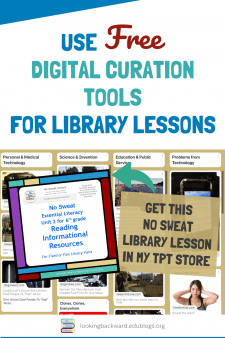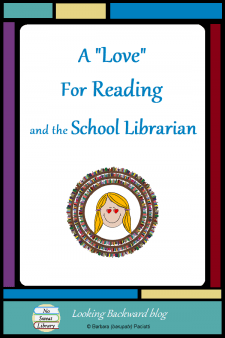 “Shouldn’t kids be able to enjoy reading?” is the question an elementary librarian asked on LM_NET, our librarians’ listserv. She was feeling frustrated by trying to meet Common Core Standards at every library visit with her itty-bitties: “Does a five year old really need to understand problem and solution in a story? Are we asking too much of our littlest ones? Are we teaching them a love of reading, or that it can be a pain?”
“Shouldn’t kids be able to enjoy reading?” is the question an elementary librarian asked on LM_NET, our librarians’ listserv. She was feeling frustrated by trying to meet Common Core Standards at every library visit with her itty-bitties: “Does a five year old really need to understand problem and solution in a story? Are we asking too much of our littlest ones? Are we teaching them a love of reading, or that it can be a pain?”
One of the biggest challenges educators face is implementing ever-changing standards, trends, and directives from administration, community, and government. How can we discern which are sustainable, long-term, best practice and which are dust in the wind?
WHAT ‘MEETING STANDARDS’ MEANS
I believe it’s important to keep in mind that Standards, of any kind or source, don’t tell us how or how quickly we accomplish a goal, but rather that students are able to meet that Standard by the end of a school year. To reference a Standard in a lesson plan does not mean we expect all students to meet the standard during that particular lesson, but only that some part of the lesson is working towards meeting the standard.
Meeting a standard doesn’t mean a student will express it in the formal language of the standard. In fact, we should expect rather the opposite: we need a kid-friendly learning goal or target aimed at short-term concept attainment that will bring students closer to the long-term understanding.
We also need to use a variety of ‘gently covert’ strategies to extract understanding from students, especially little ones. LM_NET is a great place to get ideas for expanding our repertoire. One librarian, responding to that post said this:
For in-school read-alouds, it’s a question of balance and of framing the purpose and process for an instructional read-aloud…. In my experience, when educators choose exciting books and present them in engaging ways …[kids] can learn reading comprehension strategies in the process. When we present making meaning as detective work, students, even kindergarten children, enjoy the story. Your students might also benefit from simply sharing their personal responses to stories as think-pair-share activities. (Judi Moreillon)
Another suggested this:
If you have a collection of stories then you can introduce the concepts you are focusing on cumulatively with each one by saying something like, “Remember when we read… we thought about how being in a thunderstorm made us feel. Well, our story today is set in the dead of night so I want you to think about how that might make you feel. And how it might change the way the characters in the story think and feel and act.” … In the meantime you’ve helped them all engage more with the story, increased their understanding of the sorts of techniques authors and illustrators use and kept them engaged with story and reading as a whole. (Barbara Braxton)
Based on the librarian’s post, it seemed to me that she was already charming students with delightful stories and that they were probably gaining a deeper understanding of standards than anyone could ‘test’ for, but I suggested this:
- Use a felt board to have a few students retell the story, expand the story, or tell a new ending to the story.
- Make “I have…who has” cards for a round-robin matching game to help students recall the plot of the story.
- Make finger puppets of the main characters to take home and tell the story to their parents.
Any of the above strategies can address a standard yet make it enjoyable for the student. If we use a different tactic at each storytelling, the kids don’t see it as a task, but rather as a game. Once we’ve gone through all our tactics we start over; kids are delighted to revisit a familiar activity for a new story and gradually advance toward meeting the various standards by the end of the school year.
The librarian who posed the original query seemed happy with our responses, but shortly thereafter another LM_NET post appeared from a librarian with a similar ‘love for reading’ challenge: her middle school students aren’t finishing their books.
WHEN STUDENTS AREN’T FINISHING BOOKS
As a middle school librarian, I observed students not finishing their books, and discerned the reason: quite simply, the students don’t like the books. Yes, friends, we can’t expect students to enjoy reading if they don’t enjoy the stories they’re trying to read. So, the question we need to ask is not why aren’t students finishing their books, but why don’t students like the books they choose?
The biggest problem I’ve seen is that students are rarely given enough time to find any book, let alone one that they will enjoy reading. We can help with that, as I did, by grouping our Fiction books by Subjects, the same way our Dewey books are grouped by Subjects. I originally put Subject labels on a good proportion of my fiction section, but that wasn’t enough. Students might search by subject in the online catalog or just begin browsing the aisles for story topics they like, but when their ‘time’ was up, they hadn’t been able to find what they wanted. Now that I’ve created these smaller collections of like-topic books, students find their preferred type of story much more quickly, which the teachers also appreciate.
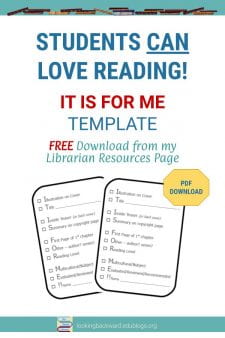 Another problem I see is that most middle school students still don’t know how to choose a good book. To solve this problem I modified another librarian’s clever mnemonic into the IT IS FOR ME! checklist and created a short video to explain how to use it. The video & checklist are now part of my 6g ELA Library Orientation lesson every year.
Another problem I see is that most middle school students still don’t know how to choose a good book. To solve this problem I modified another librarian’s clever mnemonic into the IT IS FOR ME! checklist and created a short video to explain how to use it. The video & checklist are now part of my 6g ELA Library Orientation lesson every year.
For every book checkout visit, I put stacks of the paper ‘app’—it’s about the size of a smartphone—in baskets on my library tables and students turn one in to teachers at the end of the period for a daily grade. (I always have a daily grade item for a library visit & teachers appreciate that.) Students love it because they can find a good book so much more quickly. ELA teachers love it, too, because students are actually reading their books through.
You can download my IT IS FOR ME! app as a PDF from my Free Librarian Resources page. The video is freely available on both YouTube and Vimeo. Use and share however you wish, dear reader.
ESTABLISH A READING CLIMATE WITH D.E.A.R. TIME
For many years our middle school has encouraged reading by having each grade’s ELA classes visit the library on a set day of the week, every other week throughout the school year, and the classes remain the entire period for DEAR time (Drop Everything And Read). If we truly value independent reading, then we have to not only allow students time to find a book, but we also need to give them time to become immersed in the story so they want to keep reading it. (Or if a student realizes the book is not quite what they want, the extra time gives them a chance to find a different one.)
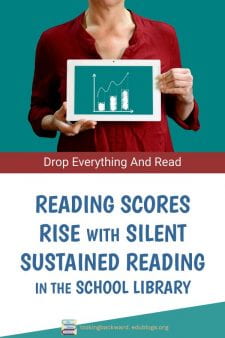 When I have a library lesson, I limit it to about 10-15 minutes so students still have the rest of the period to look for a book and begin to read it. After students are reading quietly I invite 1 or 2 tables at a time for quiet checkout; it’s more productive—and less chaotic—than letting kids check out as soon as they find a book. I challenge you to try this quiet, invited checkout procedure and see what a difference it makes in your library visits.
When I have a library lesson, I limit it to about 10-15 minutes so students still have the rest of the period to look for a book and begin to read it. After students are reading quietly I invite 1 or 2 tables at a time for quiet checkout; it’s more productive—and less chaotic—than letting kids check out as soon as they find a book. I challenge you to try this quiet, invited checkout procedure and see what a difference it makes in your library visits.
Let me just say that once we established library DEAR time every other week, the percentage of students passing our State standardized Reading Test steadily increased. In 5 years we went from below 80% to above 90%. We were so successful that our district ELA department directed all middle schools to implement silent sustained reading for their students!
ACCEPT THAT NOT EVERYONE “LOVES” READING
School Librarians can help students meet Standards, and we can promote reading in and out of the classroom. However, we must accept the fact that not every student will love reading, and many will lose interest in reading literature. To “love reading” is a hobby, just like stamp collecting or building model planes. Keep in mind that many adults don’t read books for pleasure, yet they’re proficient readers who can read a book or newspaper or magazine or webpage when they need to find an answer or solve a problem. To succeed in life, our students need to be proficient readers, not voracious ones.
We also need to encourage and promote nonfiction reading among our students as well. New Standards are requiring—and tests are using—more nonfiction. As School Librarians, our challenge needs to be, not getting students to “love reading” but, teaching our students to effectively read in order to fulfill all 5 essential literacies.
![]()


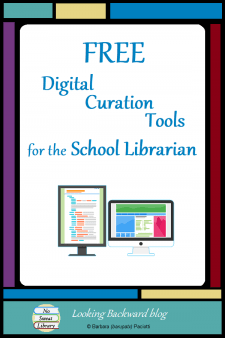
![A List of Platforms for Curation & Search [infographic] A List of Platforms for Curation & Search [infographic]](https://lookingbackward.edublogs.org/files/2017/02/curation-platforms-2izkchq.png)
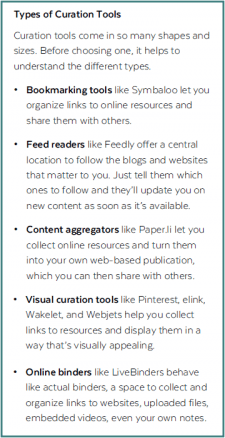 My personal resource for tech tools is
My personal resource for tech tools is 